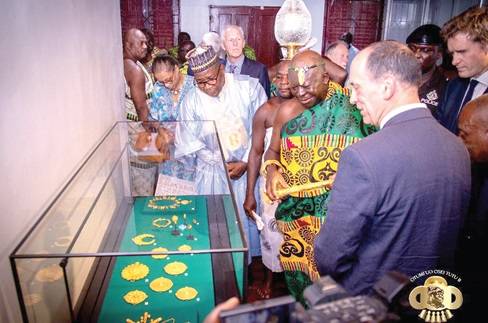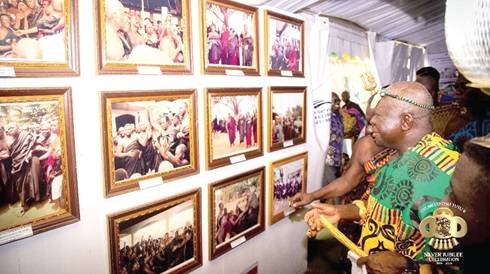
The Manhyia Palace Museum, refurbished under the auspices of the Asantehene, Otumfuo Osei Tutu II, has been re-opened to the public.
Stuffed in there are some royal artefacts looted some 150 years ago by colonial masters from the Asante Kingdom, including a ceremonial cap decorated with gold ornaments known as Mpomponsuo, a sword of state, three cast gold soul-washers’ badges, and a gold peace pipe, which were taken from the kingdom during the Anlo-Asante wars, including the infamous Sagrenti War of 1874.

Also on display are seven sections of sheet-gold ornament, one silver spoon, one pair of silver anklets and one section of sheet-gold ornament.
On display is a gold lute-harp presented by the Asantehene Osei Bonsu to British diplomat, Thomas Edward Bowdich, during a 1817 trade treaty.
Among the artefacts, 15 of them were returned by the British Museum (BM) and 17 from the Victoria and Albert Museum (V&A).
Speaking at the homecoming of the looted artefacts, Otumfuo Osei Tutu indicated that the return of the items was a restoration of the Asante spirit.
“The items that came back are virtually the soul of the people of Asante. Not all of them have returned. But, what we have here embodies the soul of Asante. Today is a day for Asantes and for the Black African continent. The spirit that we bore and share is back with us,” he said.
There are life-like mannequins of the 20th and 21st-century Asantehenes and Asantehemaas (queen mothers), with narratives of the legacy of the Asante Kingdom, including its history with the British Empire.
Last Wednesday’s event formed part of the 25th anniversary celebrations of Asantehene’s ascension to the Golden Stool as the 16th occupant.
In 1995, Otumfuo Opoku Ware II, during his Silver Jubilee, opened the museum which was originally the first Manhyia Palace, built by the British for Asantehene Nana Prempeh I in 1925, to replace the royal palace they destroyed during the Yaa Asantewaa War in 1900.
Nana Prempeh I accepted it only after paying its cost in full.
According to the Manhyia Palace Museum’s Director and Chief negotiator for the Asantehene, Ivor Agyeman-Duah, there were ongoing international movements to repatriate cultural artefacts to their rightful origins.
“Fifty years since Asantehene Otumfuo Opoku Ware II first requested the return of the items from the British Museum in 1974, Homecoming renews our connections to Britain and the United States, in the spirit of progress and cooperation,” he said.
The Fowler Museum personally returned the treasures to the Asantehene on February 8. They include a royal stool ornament from Asantehene Kofi Karikari’s private collection, who ruled during Kumasi’s sacking.
“Although the British Museum’s laws forbid the permanent removal of objects, thanks to the mutually beneficial cooperation between Otumfuos Opoku-Ware II and Osei Tutu II, and the British Museum and V&A, items removed 150 years ago are home from three museums. We now look forward to more dialogues.”
FROM KINGSLEY E.HOPE, KUMASI
